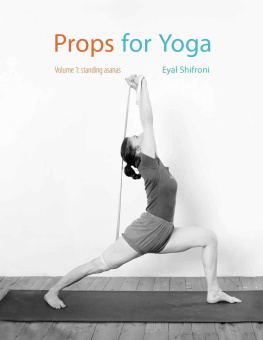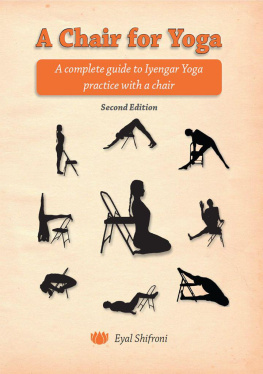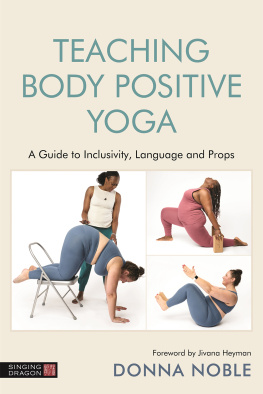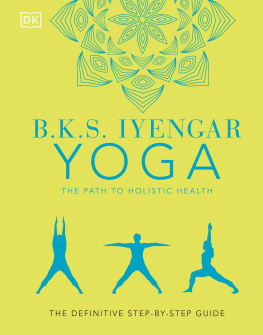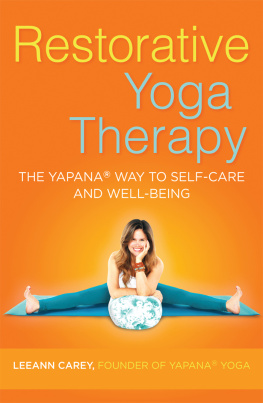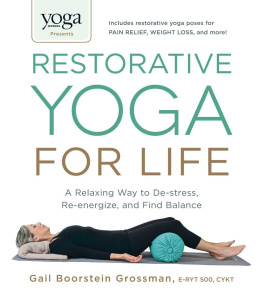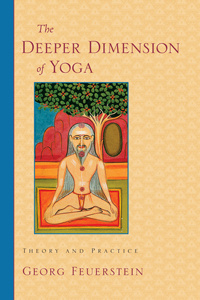Props for Yoga
A Guide to Iyengar Yoga Practice with Props Volume I: Standing Asanas
Eyal Shifroni, Ph.D.
Co-Author: Michael Sela
Based on the teachings of
Yogacharya B.K.S.. Iyengar, Geeta S. Iyengar and Prashant S. Iyengarat the Ramamani Iyengar Memorial Yoga Institute (RIMYI), Pune, India.
Photography Aviv Naveh
Text Editing Nancy Gardosh
Models Ravit Moar, Eleanor Jacobovitz, Michael Sela & Eyal ShifroniGraphic Design Aviv Gros-Allon, ViV design
Props Illustrations Kym Ben-Yaakov
No part of this publication may be reproduced, stored in a retrieval system, or transmitted in any form or by any means, electronic, mechanical, photocopying, recording, scanning, or otherwise, without the prior written permission of the author.
Copyright 2015 (2nd Printing) by Eyal Shifroni
The author of this book is not a physician and the instructions, procedures, and suggestion in this guide are not intended as a substitute for the medical advice of a trained health professional. All matters regarding your health require medical supervision. Consult your physician before adopting the procedures suggested in this guide, as well as about any condition that may require diagnosis or medical attention. The author and the publisher disclaim any liability arising directly or indirectly from the use of this guide. All rights reserved 2015 (2nd Printing)
Acknowledgmentsand Gratitude

1918 - 2014
1 Ramamani Iyengar Memorial Yoga Institute the home and teaching site of the Iyengars in Pune, India.
The source of all the knowledge presented in this guide is my Guru, the lateYogacharya B.K.S. Iyengar, Guruji as we had fondly used to call him, the founder of the Iyengar Yoga method. The use of props in yoga practice was introduced by Mr. Iyengar. The various apparatus which he invented and adapted over the years were created to enrich practice and to enable every person to benefit from the gift of Yoga. I wish to express my deepest admiration and gratitude tomy beloved Guruji, not only for being my personal teacher, but also for making yoga accessible to millions worldwide.
Guruji was so kind to go over the manuscript of my previous book, A Chair for Yoga, and to give insightful comments and suggestions. When I visited RIMYI1 in August 2014, I had planned to show him the manuscript of this volume. Unfortunately this was deemed impossible because of his failing health. I was,however, privileged to be present in Pune on the 20th of August, the day B.K.S. Iyengar left his body and to have the chance to say a last good-bye to myGuru before he travels onward, and to participate in his funeral. I will always be grateful to this man for touching my life so deeply and for offering the giftof yoga to the world through the ingenious method he developed. I wish tohumbly dedicate this book to his memory!
I have been very fortunate to have come across many inspiring teachers whohave shared their deep knowledge with me and who have shed light on Yogain general and on the use of props in particular. First and foremost are Prashantand Geeta Iyengar, I wish to thank them for their ongoing guidance and inspiration in their teaching in RIMYI. Second, I wish to thank my teacher and friend Jawahar Bangera from Mumbai, who was so kind to go over the draft of this guide and contribute many helpful comments and suggestions.
I learned a lot from many other teachers - too many to list their names here. However, I am indebted to each and every one of them and wish to express mydeep gratitude to them all.
A Chair for Yoga has received enthusiastic responses from many people in all parts of the world, students and teachers alike. It was indeed heartwarming toexperience firsthand how yoga is relevant for all human beings, regardless ofnational, cultural, religious and age differences. This network of comments and responses demonstrated in simple and real terms the truth held by yoga that all
III
of us share a Universal Consciousness (or Mahat). The feedback and requests I received from you was a strong motivator for writing this present book!
This second printing of Props for Yoga contains minor improvements relativeto the first printing (November 2014); the most significant change is in thetitles of the variations, which are now more informative.
This Guide owes its conception and delivery to my friend and colleague,Michael Sela, who helped conceive it and formulate its structure. Michael went through the text over and over again and contributed substantially toits clarity and flow. I wish to express deep appreciation for his collaboration on this project.
Thanks to Ravit Moar and Eleanor Jacobovitz, who teach with me at theZichron-Ya'akov Center, for spending so many hours modeling for the photos inthis guide.
All the teachers at our center have also contributed many beneficial ideas andfeedbacks I wish to thank all of them. Thanks also to my colleagues, EphratMichelson, Sara Tal, Nancy Gardosh and Noa Zweig for reading the manuscript of this guide and for providing many useful comments and suggestions. Nancy also went through the text carefully to correct my English and provided encouraging feedback.
I extend many thanks to my students who helped test and develop new ideasof using props during classes and workshops. Their willingness to try out these ideas and their enthusiastic feedback encouraged me to write this guide.
And, last but not least, thanks to my wife, Hagit, for her continuous love andsupport which made this guide (and many other things) possible. IV
Table of ContentsAcknowledgments and Gratitude / IIIIntroduction / IXAbout the Use of Props / XAbout this Guide / XIIThe Structure of the Guide / XIIIHow to Use this Guide / XIV Detailed Contents ofChapter 1: Understandingthe Standing Asanas (Utthistha Sthiti)
About Standing asanas3
About Tadasana4
1. Activating the feet: Block between feet 5
2. Activating the knees: Block between knees 6
3. Activating the thighs: Block between thighs7
4. Turning the upper thighs in: Belt on each groin8
5. Stabilizing the pelvis: Belt around pelvis9
6. Moving the sacrum in: Block between sacrum and wall10
7. Thighs back, buttocks in: Two opposite pulls 11
8. Sensing the bones of the legs: Standing on two blocks12
9. Extending the calves: Standing on a slant13
Arms and Chest 1410. Activating the arms: Belt around forearms1411. Moving the trapezius down: Shoulder traction 1512.Sensitizing the top chest: Belt around chest 1713. Aligning the spine: Spine on a wall edge18
1. Stretching the sides: One arm stretches the other 20
2. Activating the arms: Belt around forearms, block 21
between palms
3. Extending the armpits: Facing the wall, palms on blocks22
4. Extending the entire body upward: Holding a ceiling rope23
Vrksasana24Opening the Pelvis24
1. Moving the femur head in: Bent leg against the wall25
2. Increasing the movement of the hip joint: Back against the wall26
3. Widening the pelvis: Facing the wall27
Stretching Up284. Extending the body upward: Holding a ceiling rope 28
Adho Mukha Svanasana 29 About Adho Mukha Svanasana29
General Structure of the Pose29
1. Finding the distance between feet and palms30
2. Ensuring symmetry: Using a middle line31
Raising the Palms32
3. Shifting weight to the legs: Supporting the palms32
Working with a Partner34
4. Stretching back and up: Partner pulls backward with belt34
5. Rooting the heels: Sitting on the dog36
6. Moving in the sacrum: Two dogs37
7. Action and counter-action: Partner pushes against 38

